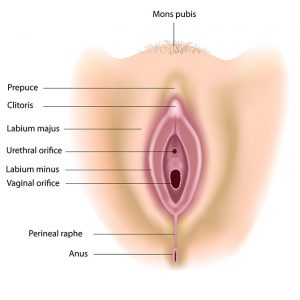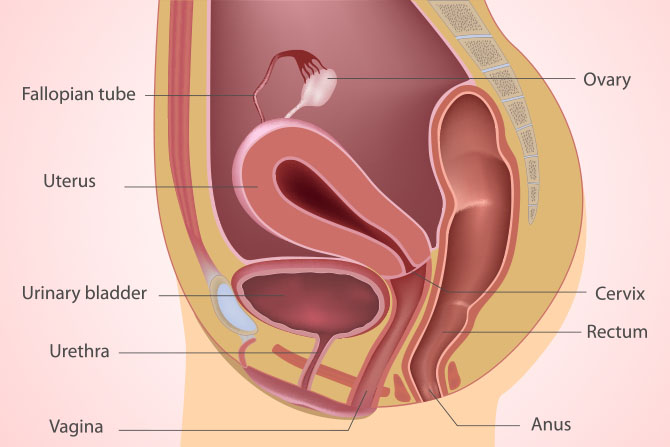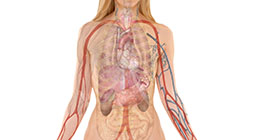Knowing one’s body is an important part of staying healthy. When people are properly educated on how different systems in the body work, as well as proper terminology, they can notice and communicate potentially serious changes to a healthcare professional. The same is true for sexual health.
In 2016, a UK survey asked 1,000 British women to locate and name the vulva, vagina, cervix, uterus, fallopian tubes, and ovaries using a medical diagram showing the female reproductive anatomy. In total, two-thirds of the women failed to identify all six parts.
A 2010 American survey found that when asked to locate the vagina, 62 percent of women could not correctly do so.
The sad truth is that most girls receive inadequate health and sex education. This leads to a lot of misinformation when it comes to genitalia and the female reproductive system.
What is Normal?
Many women feel insecure about their genitalia—a lack of knowledge of what is normal leaves them feeling abnormal. One woman told us that she did not want her husband to look at her ‘down there’ because she was deformed. She thought because she had a very long labia minora that, she was not normal. We explained that Mother Nature does not provide ‘one size fits all’ when it comes to physical assets and that some women have long labia minora while others have labia minora that look like small, flat testicles. Some women have a large clitoral hood, while others have a small one. All are normal.
Knowing your sexual anatomy is important not only for general health but it is also essential when it comes to sex and pleasure.
According to the Journal of the American Medical Association, between 22 and 28 percent of women in all different age categories have never had an orgasm. However, when women are taught how their female genitalia function, they can experience this type of pleasure. So let’s understand the beautiful female anatomy. All the structures we are discussing can provide great pleasure from sexual stimulation.
Exploring Your Sexual Anatomy
Sexual Anatomy on the Outside: The Mound of Venus
Venus, the Roman goddess of love and beauty (her Greek counterpart is the goddess Aphrodite), has lent her name to the external female sexual anatomy. The “Mound of Venus” is a lovely term for the female body’s most beautiful and sacred parts.
The fact that women can bear children and nourish them tells the world how incredible the female body is, and that wonder includes female genitalia. Sadly, many women have never looked at their genitalia. It is equally sad that many women have been told this part of their body is not beautiful.
Take a mirror and get to know your genitals. We have provided a basic diagram of what the female genitalia look like, but hundreds of variations exist. Not only is this important for your sexual health, but you can also observe if you have any bumps, moles, or growths that should be evaluated.
External Genitalia
The term ‘vulva’ includes the clitoris, the labia majora, the labia minora, the perineum, the urethra, and the anus. Some women have pubic hair from the anus to the mons pubis to their thighs. Others have very little.

The mons pubis, also called mons venus, is the soft mound of fatty flesh over the female pubic bone. During puberty, the mons pubis becomes covered with hair. This area is rich in nerves and can be a source of sexual arousal and pleasure when stimulated, or pressure is applied.
The clitoris is a very sensitive organ that contains a high concentration of nerve endings. It is covered by the clitoral hood (prepuce). It is at the top of the labia, just above the urethra (where urine is released). The clitoris has a small head called the glans. The glans have been called the small penis. The only function of the clitoris is to provide you with pleasure.
The clitoris is an extensive organ. You can only see the small head, about the size of a pea. Still, Helen O’Connell, an Australian urologist, showed that the clitoris is quite large and extends back into the pelvis. The clitoris engorges with blood upon arousal. A healthy vascular system is just as important for women as men to ensure adequate blood flow, so an orgasm is possible. Many women have to have clitoral stimulation to achieve orgasm. Orgasms can be clitoral or vaginal. Surveys of women tend to show clitoral orgasms are more common.
The labia are composed of the labia majora, or the outer lips and the labia minora or the inner lips. Pubic hair can grow on the outer lips but not the inner lips. During arousal, the labia darken in colour and become engorged with blood. Thinning of both labia can occur due to low testosterone levels and estrogens. In severe cases, the labia majora and minora shrink and fuse together, creating a very painful condition. Aging, menopause, and hormones out of balance can also change the labia.
The perineum is the hairless area between the vagina and the anus. It is composed of an internal network of muscles. Women who have had children may have had the perineum cut (called an episiotomy) to make a larger opening for the baby’s head during delivery, or the perineum could have torn during childbirth. Some women lose sensation in this area after an episiotomy; others do not. Many women find stroking or pressure on this area quite pleasurable.
Sexual Anatomy on the Inside

We have already discussed some female internal organs, including the ovaries, uterus, cervix, and fallopian tubes. Your vagina, and especially the G-spot, have specific sexual functions that are often overlooked in health class.
The vagina is a muscular, tube-shaped cavity leading from the vulva to the uterus. It is usually around 4 to 5 inches in length. It can expand to accommodate a penis or the passage of a baby. It can also contract and will hug or grasp a penis or tampon. The lining of the vagina is similar to the mucous membranes inside your mouth.
Lubrication occurs on the vaginal lining, keeping the vagina moist and free of bacteria. Some women notice that they are not as lubricated just after their period, childbirth, or during perimenopause and post-menopause, whereas during ovulation and sexual arousal, lubrication may be increased. Out-of-balance hormones can reduce lubrication.
Just inside the vagina is a ridge of muscles that tighten around the penis during intercourse. Most women report that they have little feeling past the outer third of the vagina.
Beverly Whipple and John D. Perry identified the G-spot (Grafenberg spot after the German physician who first suggested the presence of the G-spot). The G-spot is about the size of a bean on the front wall of the vagina (belly button side), approximately in front of the urethra. The G-spot is sensitive in some women; when stimulated, it becomes engorged and will increase to about the size of a nickel. Some women have intense orgasms when the G-spot is stimulated during sexual play. Others have never found a G-spot. Most women have a much easier time achieving orgasm through clitoral stimulation.
The Big O
During the 1960s, William H. Masters and Virginia E. Johnson (Masters and Johnson) brought sex out of the closet in their book Human Sexual Response. In their laboratory, they were the first to observe and describe a female sexual response, including orgasm. They found females responded in four phases: excitement, plateau, orgasm, and resolution.
Vaginal lubrication begins with secretions from the vaginal lining. In the excitement phase, the vagina and clitoris begin to swell. The breathing rate also increases.
During the plateau phase, the genitals become engorged with blood, causing the vaginal opening to narrow so it can grip the penis when inserted. The skin color of the labia deepens. A woman’s nipples can become erect.
The orgasm phase is achieved when the clitoris is stimulated, or enough pressure is applied to the cervix or surrounding vaginal wall to cause a build-up of tension or engorgement, eventually leading to a climax. Some women ejaculate from the urethra. Some women may think they are releasing a small amount of urine. Still, an analysis of the ejaculate revealed a chemical called acid phosphatase. Not all women ejaculate, nor is your pleasure diminished if you do not.
Orgasm is not the ultimate goal of a sexual experience. But it is a delightful, satisfying end to a time of intense pleasure with a partner or yourself. Women have told us that they do not have to have an orgasm to feel satisfied during lovemaking. However, they sometimes find it necessary to fake an orgasm so their partner is content and can ‘come.’ Other women are not sure if they have ever had an orgasm.
Men and women experience orgasms differently. You will not hear a man say, “I don’t think I have ever had an orgasm,” because their climax is easy to see. Women may have pelvic floor orgasms, clitoral orgasms, or nipple-stimulated orgasms, to name a few, and these orgasms may be intense or mild. Most men are unaware that the vagina has minimal sensation past the first third, where most nerves reside, so clitoral stimulation, along with other sexually arousing pleasures like kissing, touching, and petting, are essential for women to become excited enough for vaginal penetration. Without enough foreplay, most women will not be ready to accept the man, and intercourse can be painful.
Phases of the Female O
Resolution is a return to a non-aroused state. Some women feel alive and awake during this phase.
We must point out that no two individuals are the same. There is a complex interplay of factors involved in arousal and orgasm. For women, lovemaking is more pleasurable when foreplay and lots of stimulation are added to the mix. Both mental and physical stimulation is needed.










